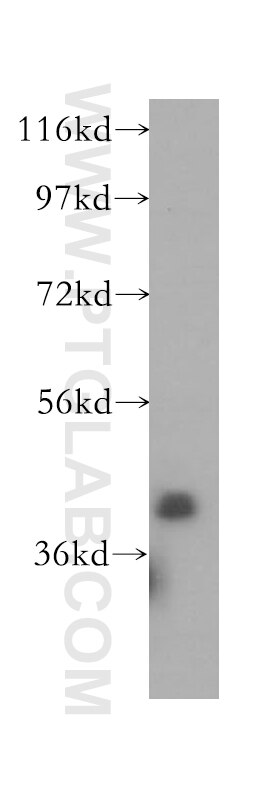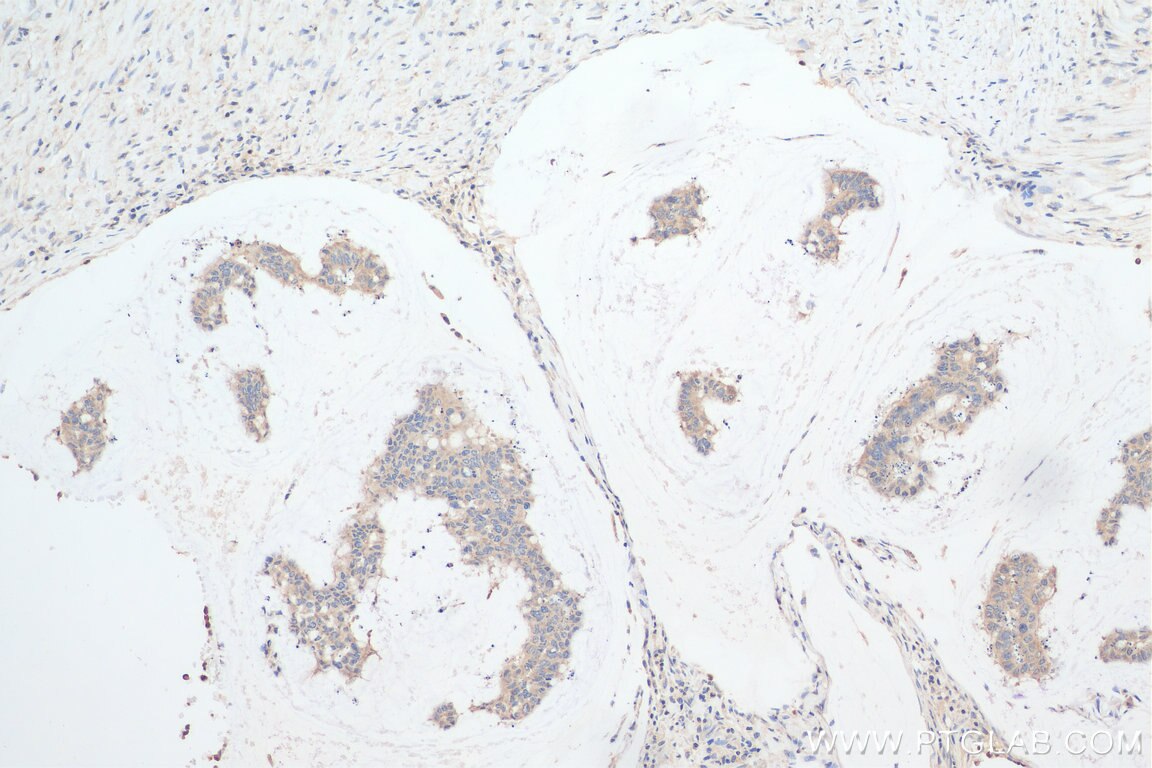- Phare
- Validé par KD/KO
Anticorps Polyclonal de lapin anti-STBD1
STBD1 Polyclonal Antibody for WB, IP, IHC, ELISA
Hôte / Isotype
Lapin / IgG
Réactivité testée
Humain, souris et plus (2)
Applications
WB, IP, IF, IHC, ELISA
Conjugaison
Non conjugué
N° de cat : 11842-1-AP
Synonymes
Galerie de données de validation
Applications testées
| Résultats positifs en WB | tissu de muscle squelettique de souris, cellules A549, cellules HeLa |
| Résultats positifs en IP | cellules A549 |
| Résultats positifs en IHC | tissu de cancer du côlon humain, il est suggéré de démasquer l'antigène avec un tampon de TE buffer pH 9.0; (*) À défaut, 'le démasquage de l'antigène peut être 'effectué avec un tampon citrate pH 6,0. |
Dilution recommandée
| Application | Dilution |
|---|---|
| Western Blot (WB) | WB : 1:500-1:2000 |
| Immunoprécipitation (IP) | IP : 0.5-4.0 ug for 1.0-3.0 mg of total protein lysate |
| Immunohistochimie (IHC) | IHC : 1:50-1:500 |
| It is recommended that this reagent should be titrated in each testing system to obtain optimal results. | |
| Sample-dependent, check data in validation data gallery | |
Applications publiées
| KD/KO | See 3 publications below |
| WB | See 10 publications below |
| IHC | See 1 publications below |
| IF | See 6 publications below |
| IP | See 2 publications below |
Informations sur le produit
11842-1-AP cible STBD1 dans les applications de WB, IP, IF, IHC, ELISA et montre une réactivité avec des échantillons Humain, souris
| Réactivité | Humain, souris |
| Réactivité citée | rat, Humain, poulet, souris |
| Hôte / Isotype | Lapin / IgG |
| Clonalité | Polyclonal |
| Type | Anticorps |
| Immunogène | STBD1 Protéine recombinante Ag2481 |
| Nom complet | starch binding domain 1 |
| Masse moléculaire calculée | 41 kDa |
| Poids moléculaire observé | 35-43 kDa |
| Numéro d’acquisition GenBank | BC022301 |
| Symbole du gène | STBD1 |
| Identification du gène (NCBI) | 8987 |
| Conjugaison | Non conjugué |
| Forme | Liquide |
| Méthode de purification | Purification par affinité contre l'antigène |
| Tampon de stockage | PBS avec azoture de sodium à 0,02 % et glycérol à 50 % pH 7,3 |
| Conditions de stockage | Stocker à -20°C. Stable pendant un an après l'expédition. L'aliquotage n'est pas nécessaire pour le stockage à -20oC Les 20ul contiennent 0,1% de BSA. |
Informations générales
STBD1 may have the capability to bind to carbohydrates. It functions as a glycogen receptor that tethers glycogen to autophagic membranes for delivery and breakdown in lysosomes. STBD1 appears molecular mass of 35-38 kDa band in mouse/rat tissues and 38-43 kDa in human tissue.
Protocole
| Product Specific Protocols | |
|---|---|
| WB protocol for STBD1 antibody 11842-1-AP | Download protocol |
| IHC protocol for STBD1 antibody 11842-1-AP | Download protocol |
| IP protocol for STBD1 antibody 11842-1-AP | Download protocol |
| Standard Protocols | |
|---|---|
| Click here to view our Standard Protocols |
Publications
| Species | Application | Title |
|---|---|---|
Acta Pharmacol Sin Asiatic acid alleviates ischemic myocardial injury in mice by modulating mitophagy- and glycophagy-based energy metabolism. | ||
J Cell Sci Stbd1 promotes glycogen clustering during endoplasmic reticulum stress and supports survival of mouse myoblasts
| ||
Mol Endocrinol Transgenic muscle specific Nor-1 expression regulates multiple pathways that effect adiposity, metabolism and endurance. | ||
J Cell Sci Mouse Stbd1 is N-myristoylated and affects ER-mitochondria association and mitochondrial morphology. | ||
J Biol Chem Starch binding domain-containing protein 1/genethonin 1 is a novel participant in glycogen metabolism. |







